THREE comets are now in range of good binoculars. Comets 41P/Tuttle-Giacobini-Kresak, C/2017 E4 Lovejoy, and C/2015 ER61 PanSTARRS are all glowing at about 6th or 7th magnitude, lovely green in deep images. See Bob King's article Comet PanSTARRS in Outburst and Binocular Bright. (For Comet 41P use the chart here; the one in the May Sky & Telescope is somewhat off.)
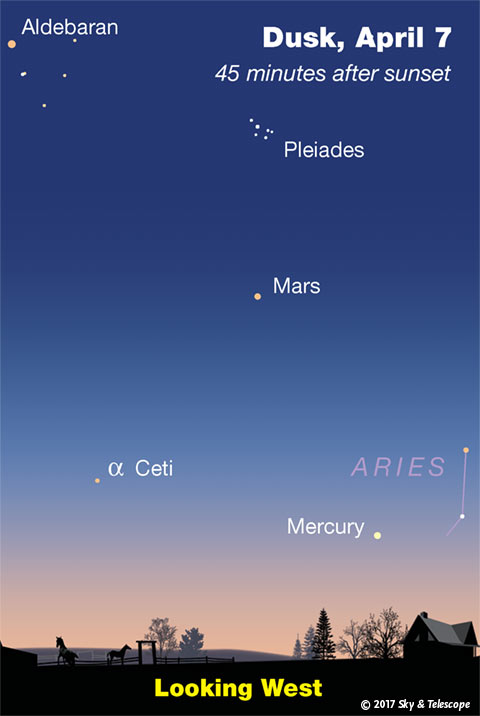
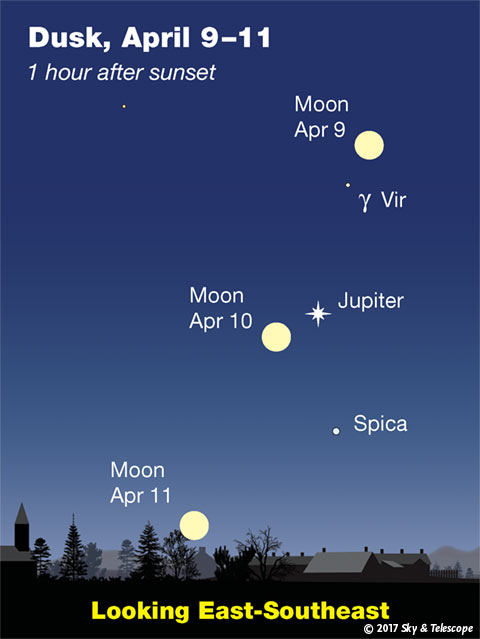
Friday, April 7
• Jupiter is at opposition: in the opposite direction from the Sun as seen from Earth. It climbs into grand view in the southeast through the evening, with slightly bluer Spica below it.
This is, however, Jupiter's most distant opposition since 2005; it's magnitude –2.5 and in a telescope appears 44.2 arcseconds across its equator. Jupiter reaches almost 50″ wide at the maxima of its opposition cycle. This last occurred in 2010 and will again in 2022.
Saturday, April 8
• Vega, the bright "Summer Star," rises in the northeast not long after dark now. Where should you watch for it to come up? Spot the Big Dipper almost overhead in the northeast. Look at Mizar at the bend of the Dipper's handle. If you can see Mizar's tiny, close companion Alcor (binoculars make it easy), follow a line from Mizar through Alcor all the way down to the horizon. That's where Vega makes its appearance.
Sunday, April 9
• Right after dark, Orion is still well up in the west-southwest in his spring orientation: striding down to the right, with his belt horizontal. The belt points left toward Sirius and right toward Aldebaran and, farther on, the Pleiades.
Monday, April 10
• Full Moon (exactly full at 2:08 a.m. tonight EDT; 11:08 p.m. PDT.) The Moon shines near Jupiter all night, as shown at right, since they're both near or at their oppositions. They may look like companions, but Jupiter is 1,700 times farther away — and 40 times larger in diameter.
Spica, about 7° below them in the evening, is 3.7 million times more distant than Jupiter — though it has only 70 or 80 times Jupiter's diameter.
Tuesday, April 11
• At this time of year, the two Dog Stars stand vertically aligned around the end of twilight. Look southwest. Brilliant Sirius in Canis Major is below, and Procyon in Canis Minor is high above.
Wednesday, April 12
• Right after dark, the Sickle of Leo stands vertical high in the south. Its bottom star is Regulus, Leo's brightest. Leo himself is walking horizontally westward, with the Sickle forming his front leg, chest, mane, and part of his head.
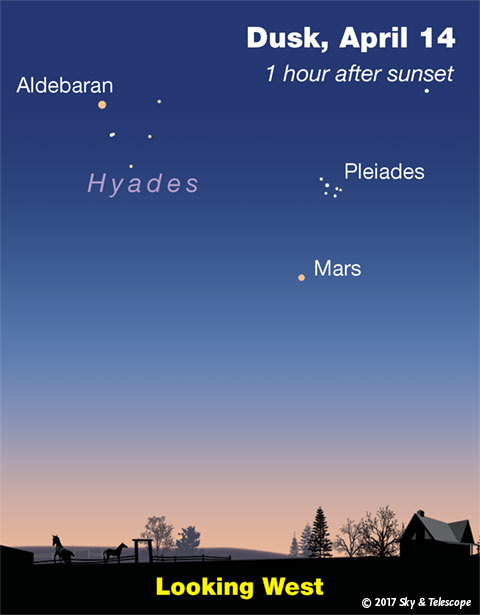
Thursday, April 13
• This is the time of year when, as the last of twilight fades away, the bowl of the dim Little Dipper extends straight to the right of Polaris. High above the end-stars of the Little Dipper's bowl, you'll find the end-stars of the Big Dipper's bowl.
Friday, April 14
• Arcturus shines brightly in the east these evenings, to the left or upper left of even brighter Jupiter (by about three fists at arm's length). Arcturus forms the pointy end of a long, narrow kite asterism formed by the brightest stars of Bootes, the Cowherd. The kite is currently lying on its side to Arcturus's left. The head of the kite, at the far left, is bent slightly upward. The kite is 23° long: about two fists.
Saturday, April 15
• Before and during early dawn Sunday morning, look for Saturn below or lower left of the waning gibbous Moon.
________________________
Want to become a better astronomer? Learn your way around the constellations! They're the key to locating everything fainter and deeper to hunt with binoculars or a telescope.
This is an outdoor nature hobby. For an easy-to-use constellation guide covering the whole evening sky, use the big monthly map in the center of each issue of Sky & Telescope, the essential guide to astronomy.
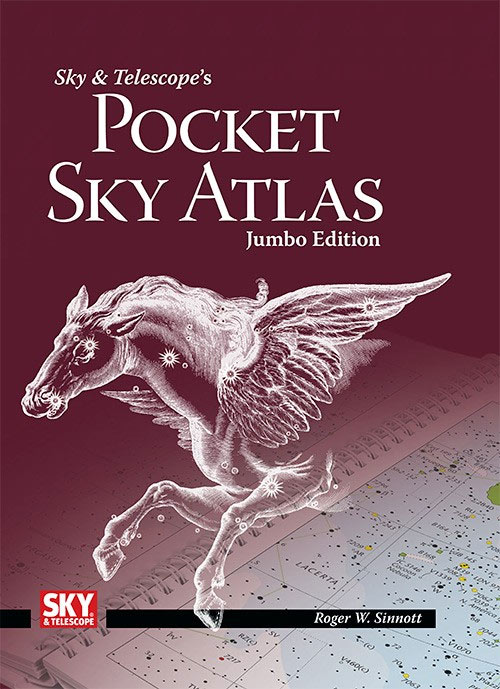
Once you get a telescope, to put it to good use you'll need a detailed, large-scale sky atlas (set of charts). The basic standard is the Pocket Sky Atlas (in either the original or Jumbo Edition), which shows stars to magnitude 7.6.
Next up is the larger and deeper Sky Atlas 2000.0, plotting stars to magnitude 8.5; nearly three times as many. The next up, once you know your way around, is the even larger Uranometria 2000.0 (stars to magnitude 9.75). And read how to use sky charts with a telescope.
You'll also want a good deep-sky guidebook, such as Sue French's Deep-Sky Wonders collection (which includes its own charts), Sky Atlas 2000.0 Companion by Strong and Sinnott, or the bigger Night Sky Observer's Guide by Kepple and Sanner.
Can a computerized telescope replace charts? Not for beginners, I don't think, and not on mounts and tripods that are less than top-quality mechanically (meaning heavy and expensive). And as Terence Dickinson and Alan Dyer say in their Backyard Astronomer's Guide, "A full appreciation of the universe cannot come without developing the skills to find things in the sky and understanding how the sky works. This knowledge comes only by spending time under the stars with star maps in hand."
This Week's Planet Roundup
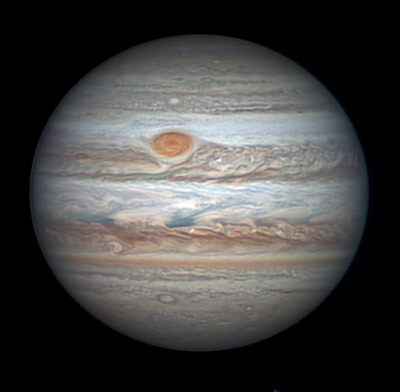
Mercury is coming down and fading out from its best evening apparition of the year. On Friday the 7th, look for it low in the west about 50 minutes after sunset, 16° lower left of Mars as seen at the top of this page. Mercury fades this week from magnitude 1.3 to 4.0 while sinking lower.
Venus (magnitude –4.5) is very low due east as dawn brightens. It's still a thin crescent in a telescope, but it's growing a little thicker every morning.
Mars (a mere magnitude +1.5, in Aries) is the orange "star" moderately low due west in late twilight, below the Pleiades. Watch the Pleiades sink down toward it day by day. Don't confuse Mars with brighter Aldebaran to the Pleiades' left.
Jupiter (magnitude –2.5, in Virgo) is at opposition on April 7th. All week it rises around sunset, shines low in the east-southeast after nightfall, high in the southeast by 10 or 11 p.m., and highest due south around midnight or 1 a.m. daylight saving time. Spica hangs 7° below it. In a telescope Jupiter is 44 arcseconds across its equator.
Saturn (magnitude +0.4, in Sagittarius) rises around 1 or 2 a.m. and glows highest in the south by early dawn, upper right of the Sagittarius Teapot. Redder Antares (magnitude +1.0) twinkles 19° to Saturn's right.
Uranus and Neptune are hidden in the glow of dusk and dawn, respectively.
__________________________
All descriptions that relate to your horizon — including the words up, down, right, and left — are written for the world's mid-northern latitudes. Descriptions that also depend on longitude (mainly Moon positions) are for North America.
Eastern Daylight Time (EDT) is Universal Time (UT, UTC, or GMT) minus 4 hours.
__________________________
"This adventure is made possible by generations of searchers strictly adhering to a simple set of rules. Test ideas by experiments and observations. Build on those ideas that pass the test. Reject the ones that fail. Follow the evidence wherever it leads, and question everything. Accept these terms, and the cosmos is yours."
— Neil deGrasse Tyson, 2014
"Objective reality exists. Facts are often determinable. Vaccines stop diseases. Carbon dioxide warms the globe. Science and reason are no political conspiracy; they are how we discover reality. Civilization's survival depends on our ability, and willingness, to do so."
— Alan MacRobert, your Sky at a Glance editor
"Facts are stubborn things."
— John Adams, 1770
Stand against falsehoods, denialism, and suppression of research. March For Science on April 22nd, in Washington DC and 500-plus other cities and towns, to “champion publicly funded and publicly communicated science as a pillar of human freedom and prosperity.”
 6
6








Comments
Joe Stieber
April 7, 2017 at 4:51 pm
There are actually at least four (4) binocular comets now. In addition to the three mentioned at the beginning of this article, I also saw comet C/2015 V2 (Johnson) in Hercules this morning (April 7, 2017). All four were seen with both 16x70 and 10x50 binoculars from a relatively dark site in the New Jersey Pinelands.
You must be logged in to post a comment.
Mujtaba
April 8, 2017 at 5:49 am
Are the time zones according to USA??? I mean I live in Pakistan so should I see Jupiter at conjunction on 8 April??? I am 10 hours ahead of CDT. As another website said that Jupiter will be at conjunction at 9:30 p.m. CDT. That will be 7 a.m. in the morning but nobody can see in the morning so should I be looking at night of 8 April in my city???
P.S. Are the times and days of comments on this website also in according to USA??? I need a quick reply as I cannot miss this event (next time it will be on May 2018).
You must be logged in to post a comment.
Mujtaba
April 11, 2017 at 11:11 am
Can anybody answer my question above?
You must be logged in to post a comment.
Joe Stieber
April 11, 2017 at 2:31 pm
Jupiter was at opposition on April 7, 2017, at 21:39 UT, therefore the 9:30 pm you saw at some other web site was probably UT rather than CDT. Based on a quick internet search, Pakistan is UT+5, so opposition there would have been on April 8 at 02:39 PKT. As far as the rising of Jupiter at sunset, reaching a decent altitude at 10 to 11 pm and setting at sunrise, etc., that would be true for local time anywhere around the earth near opposition. Since there are no significant changes in the few nights before and after opposition, other than the usual GRS and satellite movements, don't worry if you didn't see it at the exact moment of opposition. Jupiter still looks fine.
You must be logged in to post a comment.
Mujtaba
April 12, 2017 at 12:22 pm
I understand but the website: https://www.google.com.au/amp/s/jeffreylhunt.wordpress.com/2016/09/01/2016-2017-jupiters-year-wth-spica-a-triple-conjunction/amp/.
states in figure 15 that exact opposition will be on 9:30 p.m. CDT rather than UTC, because of which I was confused, you can look at the website it is CDT.
Well just not to miss any observation I looked at Jupiter on April 7 as well as on April 8 so that I would not miss it. Thank you otherwise but please tell is that website stating something wrong??? I am getting OCD!!!
You must be logged in to post a comment.
Joe Stieber
April 12, 2017 at 8:24 pm
The linked web site does not indicate opposition is "exactly" at 9:30 pm CDT. It has a diagram showing Jupiter and Spica at 9:30 pm CDT on April 7, and the caption says Jupiter is at opposition on April 7. I suspect the reference to opposition is just nominal for the day of April 7 since below that, it says "As shown in this diagram, Jupiter and Spica appear in the early evening sky on opposition night." In contrast, my specific opposition time of 21:39 UT on April 7, 2017, was generated by the U.S. Naval Observatory's Multiyear Interactive Computer Almanac software. The USNO would be the gold standard for this sort of thing. http://www.willbell.com/almanacs/almanac_mica.htm
You must be logged in to post a comment.
You must be logged in to post a comment.